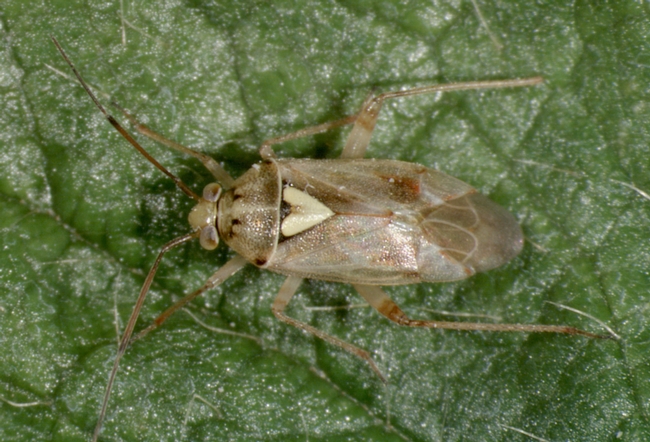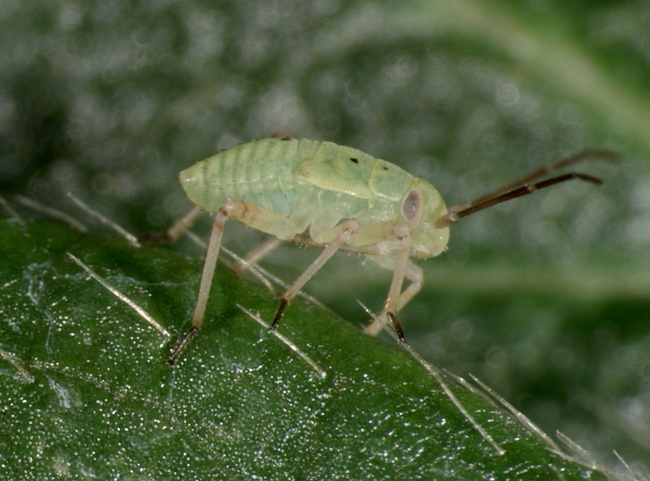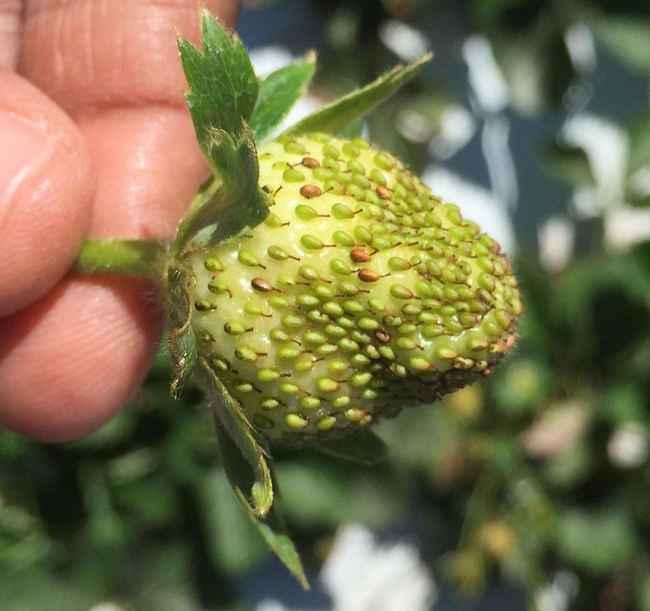Lygus bug (Lygus hesperus) adult (above) and young nymph (below). (Photos by Rodney Cooper, USDA-ARS and Surendra Dara)
Lygus bug or the western tarnished plant bug, Lygus hesperus is a major pest of strawberries in California (Zalom et al. 2014). Lygus bug has a wide host range that includes more than 100 species of cultivated crops and wild host plants (Scott, 1977; Fye, 1980 and 1982; Mueller et al., 2005) that include cultivated crops such as alfalfa, broccoli, celery, cauliflower, grapes, strawberries, and tomatoes on the California Central Coast. Additionally, ornamental and vegetable crops in greenhouses or home gardens along with weedy hosts from Chenopodiacae, Compositae, and Cruciferae in vast uncultivated landscapes offer a continuous food supply for lygus bug throughout the year. Warmer and dryer conditions as experienced in the recent years can also contribute to increased lygus bug problems. Milder winters fail to bring down overwintering populations and drought conditions dry out wild hosts early in spring forcing lygus bugs to migrate to cultivated crops. Under these circumstances, timely monitoring and implementation of appropriate management practices is necessary to limit damage and spread of lygus bugs to other crops. Vegetable crops such as celery are reported to have an increased risk of lygus bug damage in recent years (Dara, 2015a).
Damage
Lygus bugs primarily feed on inflorescence and developing seeds. They can also feed on foliage by sucking plant sap, but seeds which are rich in protein and lipids are important for the reproductive success of lygus bugs. Depending on the crop and crop stage, lygus damage can result in bud and flower loss, blemishes on seeds, necrotic spots on stems, or deformity of the fruit. In strawberries, fruit deformity caused by lygus bug renders fresh berries unmarketable. However, nearly 1/3 of the fruit deformity in strawberries is caused by factors other than lygus bug (Dara, 2015b).
Strawberry fruit deformity likely from lygus bug feeding (Photo by Surendra Dara)
Management
Lygus bugs typically move into strawberry or other cultivated crops from weedy hosts in the wild habitats in April. However, seasonal weather conditions can alter these typical patterns. In a typical fall planting of strawberries, three generations of lygus bugs can be seen. But summer-plantings, extended season for fall-plantings, or early planting of fall strawberries make the crop available almost throughout the year. Improper management of lygus or any pest can lead to increased problems in crops where the pest is not usually a problem.
While UC IPM guidelines provide details of lygus bug management in strawberries and celery, here are some important points for managing lygus bug in strawberries during and at the end of the fruit production season:
Biological control:
- Several species of predatory and parasitic arthropods provide natural control of lygus bug. Big-eyed bug (Geocoris spp.), damsel bug (Nabis spp.), minute pirate bug (Orius tristicolor), and multiple species of spiders are among the predacious arthropods. Parasitic wasps that attach eggs (Anaphes iole) and nymphs (Peristenus relictus) are commonly found in strawberries. Conserving natural enemies by providing flowering hosts as refuges and selecting chemicals that are less harmful can contribute to biological control.
Cultural control:
- Manage weeds near and around strawberry fields that serve as sources of lygus bug infestations.
- Some studies suggest growing strips of alfalfa or flowering hosts that attract lygus bugs and managing them with pesticides or vacuuming. This practice requires close monitoring to prevent dispersal of lygus bugs to strawberries.
Chemical control and biopesticides:
- A variety of chemicals that belong to different mode of action groups are registered for lygus bug in strawberries. Select appropriate label rates to obtain desired control. Using surfactants and proper application techniques can improve control efficacy.
- Rotate chemicals from different mode of action groups to reduce the risk of resistance development.
- Use appropriate materials for appropriate life stages of the pest. For example, an insect growth regulator like novaluron (Rimon) is effective against nymphal stages. To control a mixed population of nymphs and adults, novaluron can be used with other insecticides. Botanical insect growth regulator like azadirachtin (e.g., AzaGuard, Debug Turbo, Molt-X, and Neemix), which also has insecticidal properties, can be used with chemical pesticides. Microbial pesticides based on insect pathogenic fungi such as Beauveria bassiana (BotaniGard), Isaria fumosorosea (Pfr-97), and Metarhizium brunneum (Met52) in combination with azadirachtin or chemical pesticides can also be used as a part of the lygus IPM program.
Mechanical control:
- Bug vacuums can help remove lygus bugs from strawberry plants. They are typically run twice a week at a speed of 2 mph. Improved design and increased number of passes each time can enhance the control efficacy. Vacuums may not be effective in removing all life stages of lygus bugs and may also remove beneficial arthropods.
Control specific to end of the season:
- Do not neglect managing lygus until the end of the fruit production. Negligence can lead to the spread of the pest to neighboring fields requiring aggressive management practices. Such a situation that demands additional pesticide applications can lead to insecticide resistance in the long run.
- Some growers indicated that sulfuric acid applied as soil amendment at the end of the season helped in controlling lygus bugs. This practice is, however, not recommended for lygus management.
IPM strategies:
Several IPM studies in the Santa Maria area with a focus on lygus bug management provide information on effective chemical and non-chemical options.
- 2012: //ucanr.edu/blogs/blogcore/postdetail.cfm?postnum=9595
- 2013: //ucanr.edu/blogs/blogcore/postdetail.cfm?postnum=19290
- 2014: //ucanr.edu/blogs/blogcore/postdetail.cfm?postnum=19294
- 2015: //ucanr.edu/blogs/blogcore/postdetail.cfm?postnum=19641
http://ucanr.edu/articlefeedback
References
Dara, S. K. 2015a. Increasing risk of lygus bug damage to celery on the Central Coast. (//ucanr.edu/blogs/blogcore/postdetail.cfm?postnum=19221)
Dara, S. K. 2015b. Role of lygus bug and other factors in strawberry fruit deformity. (//ucanr.edu/blogs/blogcore/postdetail.cfm?postnum=19630)
Fye, R. E. 1980. Weed sources of lygus bugs in the Yakima Valley and Columbia Basin in Washington. J. Econ. Entomol. 73: 469-473.
Fye, R. E. 1982. Weed hosts of the lygus (Heteroptera: Miridae) bug complex in Central Washington. J. Econ. Entomol. 75: 724-727.
Mueller, S. C., C. G. Summers, and P. B. Goodell. 2005. Composition of Lygus species found in selected agronomic crops and weeds in the San Joaquin Valley, California. Southwest. Entomlo. 30: 121-127.
Scott, D. R. 1977. An annotated list of host plants for L. hesperus Knight. Bulletin of the Entomological Society of America 23: 19-22.
Zalom, F. G., M. P. Bolda, S.K. Dara, and S. Joseph., 2014. UC IPM pest management guidelines: strawberry. University of Californi a Statewide Integrated Pest Management Program. Oakland: UC ANR Publication 3468.



